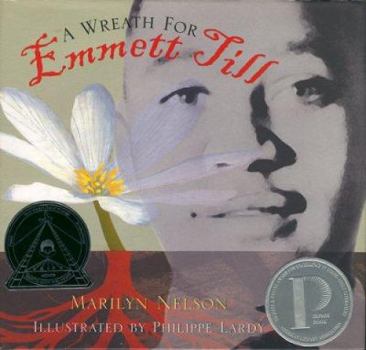A Wreath for Emmett Till
Select Format
Select Condition 
Book Overview
2006 Coretta Scott King Honor Book In 1955, people all over the United States knew that Emmett Louis Till was a fourteen-year-old African American boy lynched for supposedly whistling at a white woman... This description may be from another edition of this product.
Format:Hardcover
Language:English
ISBN:0618397523
ISBN13:9780618397525
Release Date:April 2005
Publisher:Houghton Mifflin
Length:48 Pages
Weight:0.68 lbs.
Dimensions:0.4" x 8.0" x 7.5"
Age Range:12 years and up
Grade Range:Grade 7 and higher
Customer Reviews
3 ratings
For Whom the Bell Tills/Tolls
Published by Thriftbooks.com User , 17 years ago
The tragic story of the death of Emmett Till, Jr. in 1955 is one that plays a large part in the Civil Rights movement. Till, then 14 a Chicagoan was visiting relatives in the South. He said "hi, baby" to a woman who was white. The hue and cry was fierce; how dare this child talk to someone who was not of the same race? To make matters worse, a posse was formed and Till as well as his cousin were roused from their beds and taken from the house they were in. Emmett Till, Jr. was beaten to death. What makes this child's tragic death a turning point was that Till's mother had his funeral televised with an open casket. The world at large would see just what bigotry, ignorance and hatred was capable of and of one young casualty it claimed. Till's mother, who died in 2003 never stopped beating on the drum for her only child and for an end to cruelty and bigotry. Hers was a voice that was heard by people such as President Johnson (1963-68); Attorney General and later Senator Robert Kennedy; Martin Luther King and countless others. To this day I cannot watch that funeral dry eyed; the thought of the anguish this child's mother endurned for the remainder of her life is just....painful. Emmett Till Jr.'s death, which took place some 10 years before Bloody Sunday aka March 7, 1965 was a touchstone event. In looking at the Civil War Movement; the riots; the efforts of many to secure fair and equal treatment for ALL individuals can look toward Emmett Till, Jr. as an unlikely martyr. This child's needless death, horrible as it was did call attention to similar racist-based atrocities being committed. As heinous and atrocious the injustice to this child was, Marilyn Nelson offsets the horror with some beautiful poetry. The rhythm and flow of the words and the idyllic images contained in some of the sonnets stand in stark contrast to the ugly, leering head of Jim Crow and the Racist Regime that flourished.
Beautiful Poem
Published by Thriftbooks.com User , 18 years ago
This book is in the form of a Heroic Sonnet is a brilliantly written book. It is about giving a wreath to Emmett Till, a young child who was lynched after whistling at a white woman. Till, who normally lived in Chicago, was spending the time at his uncle for the summer. After whistling at a white woman, Briant, Milan and a third person kidnapped Emmett Till. Soon after the kidapping, they lynched him. Later in the Trial, Briant and Milan were found not guilty, though later, it was proven they were guilty. This book was brilliantly written into a heroic sonnet, each of the first lines stating: R.I.P. EMMETT L. TILL. It got me emotionally connected, displeased by the racism people had back then (i.e. allowing Briant and Millan the right to be not guilty just because Till was Black). This book was brilliantly written through the use of similies. It allowed you to invision the racism back then. The only comment I have against it is the World Trade Center reference, mentioning 9/11 hadn't happened yet. Other than that, A Wreath for Emmet Till by Marilyn Nelsen was an excellent work of poetry.
From Sisters Nineties Literary Group Book Review Editor
Published by Thriftbooks.com User , 19 years ago
A Wreath for Emmett Till is my first encounter with Marilyn Nelson; a bittersweet introduction. As a member of the Sisters~Nineties Literary Group, this book fascinates me as it is a beautiful example of poetic mastery. When our editor gives us a writing assignment for our publication, I grumble and protest, then I revel in the experience; delighting in the success of learning about the world of poetry and all its various forms. The "sankofet," created by Debra Morrowloving Sisters~Nineties founder, comes to mind as I read this book.* Ms. Nelson's rhyme scheme is a fourteen-line sonnet on each page linking the previous poem with the next as the last line of the previous poem is the first line of the next poem on the following page. In the world of poetry, this is known as a "crown of sonnets." Although written for children, I had to read the book twice to "feel" the horrible images that this book so beautifully captures. References to flower, plants, and trees are symbolic and make up the "wreath" for Emmett. Please read this book and share the experience with your children. The incident is described as the motivating force of the Civil Rights Movement. It is also a wake-up call to all those who continue to live a life of apathy and denial when it comes to standing up for the legacy of the African American struggle. *Sankofet is a poetic form of three stanzas, each with seven lines. The fourth line of each stanza is the same. The last word of each stanza is the first word of the subsequent verse, and the last line of a Sankofet is the first line in the poem. The format of the Sankofet emulates the call-and-response motif of Afrikan musical tradition with the repetition of the fourth lines. The connecting words at the beginning and end of the stanzas represent the Afrikan cycle of life concept.






